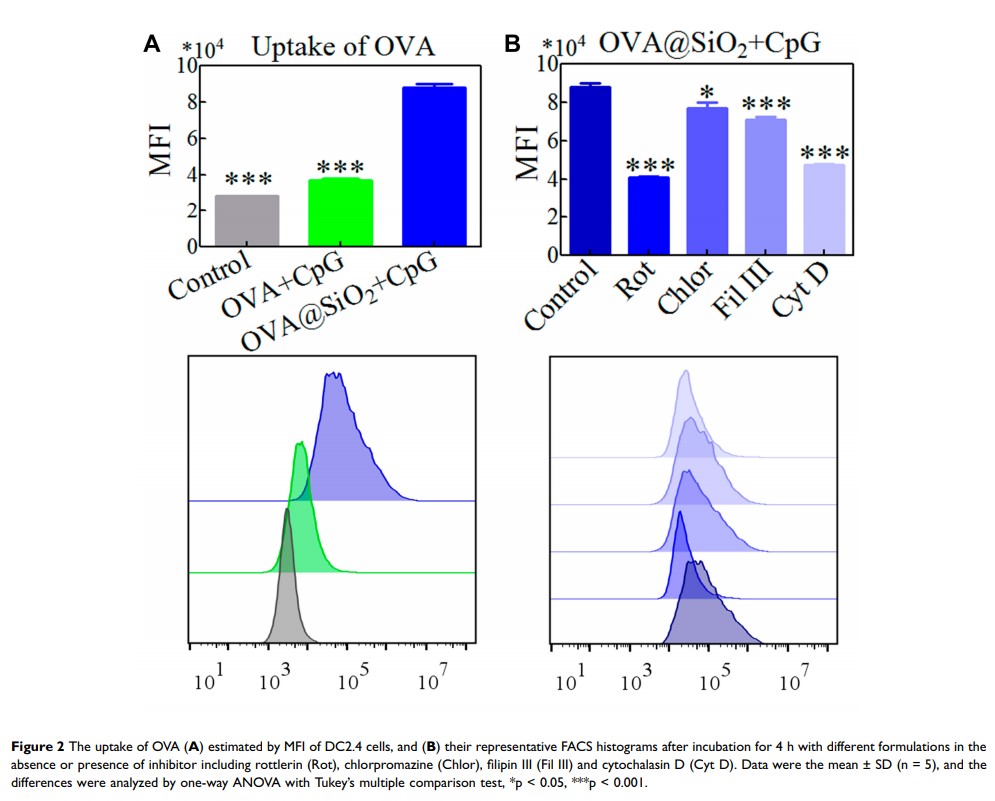9 1 2 3 6
论文已发表
注册即可获取德孚的最新动态
IF 收录期刊
- 2.6 Breast Cancer (Dove Med Press)
- 3.9 Clin Epidemiol
- 3.3 Cancer Manag Res
- 3.9 Infect Drug Resist
- 3.6 Clin Interv Aging
- 4.8 Drug Des Dev Ther
- 2.8 Int J Chronic Obstr
- 8.0 Int J Nanomed
- 2.3 Int J Women's Health
- 3.2 Neuropsych Dis Treat
- 4.0 OncoTargets Ther
- 2.2 Patient Prefer Adher
- 2.8 Ther Clin Risk Manag
- 2.7 J Pain Res
- 3.3 Diabet Metab Synd Ob
- 4.3 Psychol Res Behav Ma
- 3.4 Nat Sci Sleep
- 1.9 Pharmgenomics Pers Med
- 3.5 Risk Manag Healthc Policy
- 4.5 J Inflamm Res
- 2.3 Int J Gen Med
- 4.1 J Hepatocell Carcinoma
- 3.2 J Asthma Allergy
- 2.3 Clin Cosmet Investig Dermatol
- 3.3 J Multidiscip Healthc

抗原共轭的二氧化硅固体小球作为纳米疫苗用于癌症免疫治疗
Authors Dong Y, Gao J, Pei M, Wang X, Zhang C, Du Y, Jiang Y
Received 15 December 2019
Accepted for publication 8 April 2020
Published 22 April 2020 Volume 2020:15 Pages 2685—2697
DOI https://doi.org/10.2147/IJN.S242463
Checked for plagiarism Yes
Review by Single-blind
Peer reviewer comments 4
Editor who approved publication: Dr Linlin Sun
Background: Nanocarriers could deliver significantly higher amounts of antigen to antigen-presenting cells (APCs), which have great potential to stimulate humoral and cellular response in cancer immunotherapy. Thereafter, silica solid nanosphere (SiO2) was prepared, and a model antigen (ovalbumin, OVA) was covalently conjugated on the surface of SiO2 to form nanovaccine (OVA@SiO2). And the application of OVA@SiO2 for cancer immunotherapy was evaluated.
Materials and Methods: SiO2 solid nanosphere was prepared by the Stöber method, then successively aminated by aminopropyltriethoxysilane and activated with glutaraldehyde. OVA was covalently conjugated on the surface of activated SiO2 to obtain nanovaccine (OVA@SiO2). Dynamic light scattering, scanning electron microscope, and transmission electron microscope were conducted to identify the size distribution, zeta potential and morphology of OVA@SiO2. The OVA loading capacity was investigated by varying glutaraldehyde concentration. The biocompatibility of OVA@SiO2 to DC2.4 and RAW246.7 cells was evaluated by a Cell Counting Kit-8 assay. The uptake of OVA@SiO2 by DC2.4 and its internalization pathway were evaluated in the absence or presence of different inhibitors. The activation and maturation of bone marrow-derived DC cells by OVA@SiO2 were also investigated. Finally, the in vivo transport of OVA@SiO2 and its toxicity to organs were appraised.
Results: All results indicated the successful covalent conjugation of OVA on the surface of SiO2. The as-prepared OVA@SiO2 possessed high antigen loading capacity, which had good biocompatibility to APCs and major organs. Besides, OVA@SiO2 facilitated antigen uptake by DC2.4 cells and its cytosolic release. Noteworthily, OVA@SiO2 significantly promoted the maturation of dendritic cells and up-regulation of cytokine secretion by co-administration of adjuvant CpG-ODN.
Conclusion: The as-prepared SiO2 shows promising potential for use as an antigen delivery carrier.
Keywords: antigen delivery, silica solid sphere, nanovaccine, cancer immunotherapy
